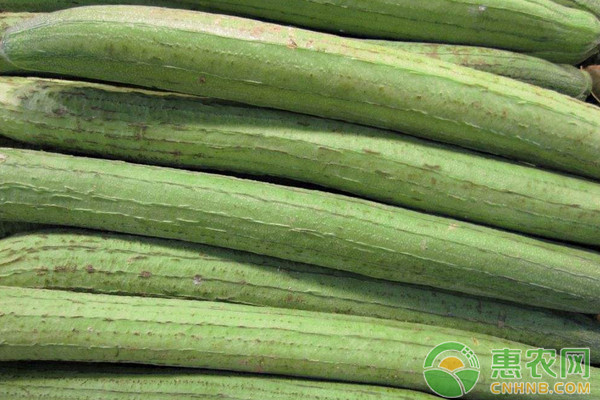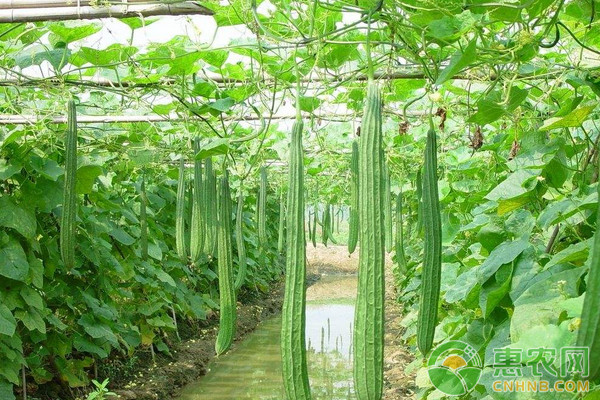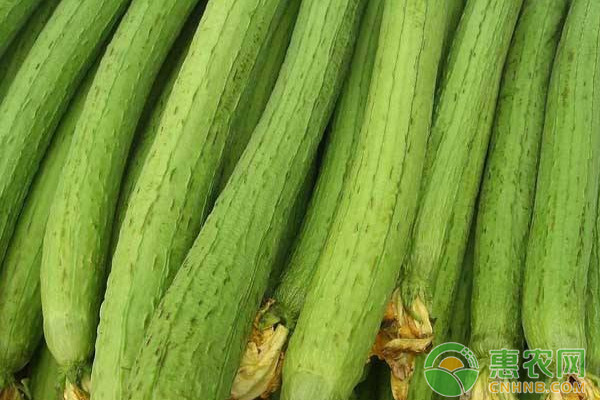Nowadays, soilless cultivation technology is a popular cultivation method at present, because it has the characteristics of water saving, fertilizer saving, labor saving, high yield and high quality. The following Huinong.com Xiaobian compiled a loofah soilless cultivation technique for everyone.

1 variety selection
The loofah is divided into two categories: ribbed gourd and fragrant loofah. The surface of the loofah has no ribs, smooth or fine wrinkles. The melons are mostly cylindrical, and the young melons are tender and tender. It has strong growth potential, high yield, wide distribution and strong adaptability. It is cultivated in both north and south. Excellent varieties include white jade cream, silk loofah, and Hangzhou pork loofah. The growth of the stalked loofah is weaker than that of the unleaved loofah, and the fruit is long rod-shaped or spindle-shaped. The most characteristic feature is that there are 9 to 11 raised ridges on the surface of the fruit. Excellent varieties include green skin loofah, green wolverine and so on.
2 cultivation methods
Soilless cultivation of loofah can be cultivated by hydroponics and substrate. Matrix culture management technology is easier than hydroponic culture. Especially in the design of “fruit and vegetable promenadeâ€, there are also loofahs. Therefore, with the scaffolding facilities, loofah in the form of brick trough, bag, basin, box, etc. The substrate is cultivated with good results.
3 Cultivation techniques
3.1 Nursery
Use nutrient 钵 seedlings. Soak the selected seed warm soup for 4h, then disinfect with 2% potassium permanganate for 2~3h, remove it with water and rinse it at 25~30°C. When 80% of the buds grow to 0.3-0.5cm, select the sunny day to be spotted into the nutrient bowl filled with the substrate, cover the 1cm thick substrate after sowing, and then cover with a layer of film to keep warm.

3.2 Seedling management
3.2.1 Temperature Management
3 to 4 days after sowing, keep 30 to 32 ° C during the day and 18 to 20 ° C during the night. After the emergence of the seedlings, the mulch film is removed in time, and the temperature is appropriately lowered after the seedlings are kept, and the temperature is maintained at about 25 ° C during the day and 15 to 18 ° C at night. About 30 days, when the seedlings have 3 to 4 true leaves, they can be planted, and the seedlings should be strengthened 10 days before planting.
3.2.2 Water Management
The water content of the substrate should reach 60% to 70% of the maximum water holding capacity in the field, and watering in the morning is best.
3.2.3 Lighting Management
Seedling stage is the key period of flower bud differentiation. Low night temperature and short day sunshine are beneficial to promote flower bud differentiation and female flower formation. Therefore, it is necessary to adjust the light time and day and night temperature difference. It can be shaded by a small arch shed, so that the daily sunshine time is controlled at 8 to 9 hours.
3.3 Cultivation tank specifications and matrix ratio
If it is produced in a greenhouse or greenhouse, the cultivation tank is 70-80 cm wide and 25-30 cm deep, and the length depends on the span of the greenhouse. If it is used for the cultivation of the melon and fruit corridor, it can be grooved or bagged on both sides of the corridor. The planting groove can be 40cm wide. The bottom of the cultivation tank is covered with a layer of plastic with drainage holes. The cultivation substrate was selected from peat charcoal: vermiculite: perlite = 3:1:0.5 by volume ratio, mixed and uniformly disinfected, and then filled into the cultivation tank. The matrix was formed into a turtle-shaped shape, and a black plastic film was laid on the upper layer. permeable.
3.4 Colonization
When the loofah seedlings have 3 to 4 true leaves, they can be colonized. It is advisable to choose the clearing of the morning in the clear weather. The greenhouse trough cultivation adopts double row planting, the small row spacing is 60cm, the plant spacing is 40cm, and the planting trough spacing is 80~100cm. Take care to protect the roots intact and unharmed. The planting density varies according to the variety, cultivation area, cultivation season and pruning form, and is generally controlled at about 2,000 per acre.
3.5 Temperature and humidity management
The high ambient temperature should be maintained within 1 week after planting, at 28 °C during the day and 15-18 °C during the night. In order to prevent high temperature damage to the plant, the ambient humidity can be increased. After the seedlings are slowed down, in order to promote the development of the root system and prevent the stems and leaves from growing, the temperature during the daytime is controlled at 20 to 28 ° C and at night to 12 to 18 ° C. During the flowering period, the temperature is slightly increased, but the maximum temperature in the shed cannot exceed 35 °C, and the night temperature is not lower than 10 °C. In the case of heat preservation and ventilation, the ambient humidity should be controlled at 60% to 70%.
3.6 Nutrient management
3.6.1 Nutrient solution formula
The Japanese Garden Test Formula (1966) was selected.
3.6.2 Nutrient concentration management
The nutrient solution concentration management index is: seedling stage 1.0mS/cm, planting to flowering stage 2.0mS/cm, fruit expansion period 2.5mS/cm, maturity period to harvesting period 2.8mS/cm.
3.6.3 pH
A suitable pH for the growth of loofah is 6.0 to 6.8.
3.6.4 Liquid supply and water management
Loofah enjoys a humid climate, is resistant to high humidity, and keeps the substrate moist. Generally, the liquid is supplied once every 1 to 2 days in the seedling stage, and the liquid supply is 1 to 2 times per day in the mature stage, and the amount of liquid per supply is 0.5L to 2L per plant depending on the size of the plant. The concentration of nutrient solution can be appropriately reduced on sunny days, and the concentration of nutrient solution can be appropriately increased in rainy and cold seasons. After pouring the nutrient solution 2 to 3 times, you can pour water once.

3.7 Plant adjustment
In the greenhouse, the trough cultivation should be carried out in time when the plants begin to pump. A wire is pulled between the greenhouse skeleton and the back wall in the north-south direction above the planting trough, and a nylon rope is attached to the plant on the wire, and then the man-made vine is artificially introduced to assist the shelf. The main vine and the side vine of the loofah can be melon, usually the side vines below the first female flower are all removed, and the side vines appearing later, choose to stay strong and grow, and leave a leaf in front of the melon to pick the heart. Leave 2 to 3 loofah per plant. In the later stage, you only need to cut out the weak or overly dense branches. As the stems grow, it is necessary to wrap the vines in time, so that the stems of the plants are always maintained at a height of about 1.5 m. Before the vines are removed, the middle and lower leaves, diseased leaves, yellow leaves and tendrils are removed, which can improve the ventilation and light transmission conditions. . If it is cultivated on both sides of the melon corridor, the vines on the front side of the scaffolding are removed, and the side vines after climbing the scaffolding are generally not removed, but attention should be paid to the vines. During the fruiting period, if the plants grow too vigorously, the leaves are luxuriant, the old leaves, yellow leaves and excess male flowers are removed, and the young melons that are placed on the shelf or wrapped by the tendrils are adjusted in time to hang in the scaffolding. Remove the deformed melon to reduce nutrient consumption and increase the viewing effect.
3.8 Preserved fruit
Loofah has no single-strength ability, and artificial cultivation is required for indoor cultivation in the greenhouse. It can be artificially pollinated at 8 to 10 in the morning without dew. Remove the male flower that has just been opened, remove the petals, and gently apply the female flower stigma with anther. If the amount of male flowers is insufficient or the loose powder is difficult, spray with 25mg/L of sitting fruit.
3.9 Harvesting
The loofah is only 10 to 12 days from the opening of the female flower. When the stalk is smooth and slightly discolored, the flesh of the fruit is reduced, and the peel can be picked and eaten with a soft touch. After harvesting, the fruit is prone to fibrosis, and the seeds become hard and bitter and cannot be eaten. Therefore, it is best to harvest once every 1~2d during the flowering period. The harvesting time should be in the morning. Use scissors to cut at the Qiguo handle. Since the loofah peel is tender, it is necessary to gently put it under pressure to avoid affecting the commerciality.
Regarding the soilless cultivation technology of loofah, we will talk about this today. We welcome the interested farmers to come to Huinong.com.
The so-called veterinary drugs, referred to as veterinary drugs, refer to drugs that can regulate the function of livestock from the body and prevent and cure livestock and poultry diseases. Natural plants, animals, minerals, and synthetic drugs and immunizations can all be used as veterinary drugs. Feed additives used in animal production are also often included in the category of veterinary medicines
Veterinary Drug,Hyaluronic Acid Powder,Oxytoci Acetate,Dmaa Powder
Shaanxi YXchuang Biotechnology Co., Ltd , https://www.peptide-nootropic.com